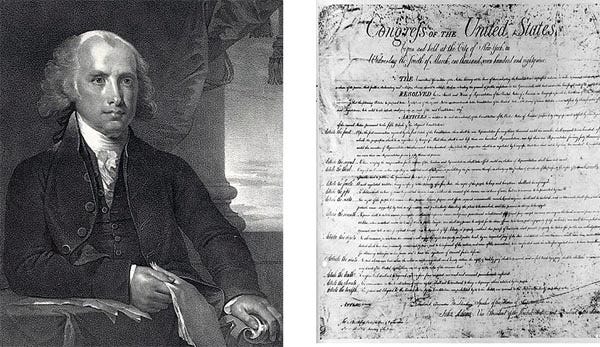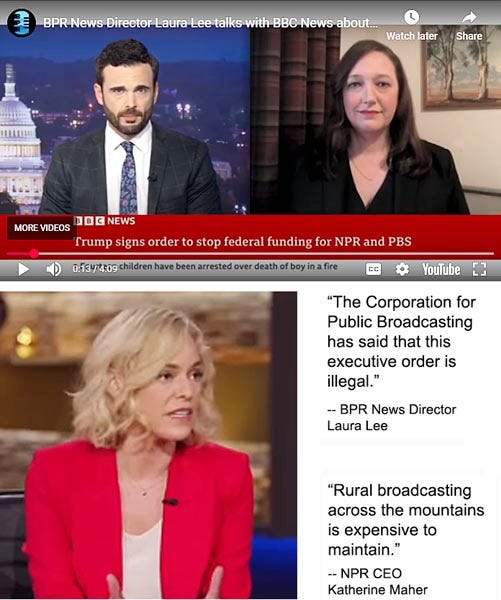Can Freedom of the Press Win in Western North Carolina?
Blue Ridge Public Radio is in public broadcasting's fight to stay on the air, and we can help them make history
Sam and I have supported Blue Ridge Public Radio (BPR) for a long time, and not just by listening. We donate. I remember a day when we were driving with the radio tuned to WCQS, maybe to On the Media. Suddenly I realized the announcer was naming Sam as a Day Sponsor — and wishing me a happy anniversary!
The Story of Public Radio in Western North Carolina
Speaking of anniversaries, WCQS began about 45 years ago this August as WUNF-FM, a 10-watt station at the University of North Carolina Asheville. In 1984 Western North Carolina Public Radio (WNCPR) bought the station, calling it WCQS and eventually making it a member of National Public Radio (NPR).

Since 2021, BPR has had two frequencies: BPR News, with news coverage and analysis; and BPR Classic, with music, storytelling and more.
BPR serves fourteen counties in Western North Carolina. Recent surveys report that more than 80,000 listeners tune in weekly. In 2023 and 2024 BPR added five local reporters to bring the team to a total of eight. This expansion came at critical time as expansive reporting was needed in the aftermath of Hurricane Helene.

The Story of Freedom of the Press in America
On December 13, 1791, the First Amendment to the United States Constitution was ratified. It confirmed the fundamental rights of its citizens, including freedom of the press.
However, I have read, “the amendments are frequently reinterpreted in fresh contexts and changing times.” Our times?

Fast forward to 1971. President Nixon claimed executive privilege and tried to stop publication of the then-classified Pentagon Papers, which The New York Times had in its possession. The Supreme Court ruled against Nixon and upheld the First Amendment.
But what was happening with public radio and television?
In 1967, Congress established the Corporation for Public Broadcasting (CPB), to be funded, in part, by taxpayers.
Republican opposition came quickly. Presidents Nixon, Reagan, and G. W. Bush all called for cutting the costs of the CPB; and in 1994, Speaker of the House Newt Gingrich called public broadcasting “biased television” and threatened to defund it entirely.

But the Supreme Court was not alone in defending America’s free press. In 1997, a Republican-controlled House voted down a measure to eliminate the CPB from the federal budget by the year 2000.
And in 2005, with Republicans in control of both chambers of Congress and the White House, a move to defund the CPB was rolled back.
Today’s threat to the freedom of the press
Today, we can’t count on the President, on Congress, or even the Supreme Court to defend the First Amendment for us. On May 1, the President ordered that
the CPB Board of Directors and all executive departments and agencies cease Federal funding for NPR and PBS.
Public radio and television are on the front lines against a volley of threats from Washington and they’re fighting back.
BPR’s General Manager Ele Ellis recently wrote,
This move could impact every local station in the country, including a loss of $300,000 for Blue Ridge Public Radio.
This signals a broader effort to destabilize the foundation of public broadcasting. The future of BPR and public media itself will be at stake.
To survive, we need your help — now.
And National Public Radio’s CEO Katherine Maher said on The Daily Show that in rural areas, people count on stations like BPR to widely broadcast local news and vital disaster information, as they did during Helene.
How to join BPR in defending America’s free press in 2025
See my links to three ways to donate to BPR in the notes following this post.
Listen to BPR and spread the word that they face federal defunding.
Come to the White Squirrel Festival this Saturday in Brevard, NC, May 24, and meet members of Blue Ridge Public Radio staff along with volunteers at the BPR booth. Tell them you support their efforts — and tell them Deda sent you!
Just in — Exciting news from BPR!
Today, May 23, BPR will officially launch WNQS 89.7 FM, a new transmitter that significantly expands our coverage area for both BPR News and BPR Classic in Sylva and surrounding communities. This expansion will bring our programming to approximately 22,000 listeners—an increase of 8,000 new listeners in the region. Thanks to upgrades by BPR’s technical team, improved signals are now available across Jackson County and nearby areas.
Frequency Changes by Area:
Sylva:
BPR News moves from 91.5 FM to 89.7 FM (stronger signal).
BPR Classic will soon be available on 91.5 FM.
Canton & Clyde:
BPR News moves from 89.7 FM to 89.1 FM.
Cullowhee:
Most listeners will continue receiving BPR News on 89.7 FM.
Some may need to switch to 88.3 FM for optimal reception.
This means 15,000 Sylva-area residents will gain access to BPR Classic for the first time—bringing more trusted news and beloved music to more homes. We’re thrilled to continue our mission of delivering high-quality public radio to more people across Western North Carolina.
Also —
Members of the Blue Ridge Public Radio staff have received four Regional Edward R. Murrow awards, including an “Overall Excellence” designation within our division recognized by The Radio Television Digital News Association (RTDNA). You can read more about these here. Three cheers for BPR’s news team!






very helpful, as always!
Thank you very much for this valuable and important information, Deda.